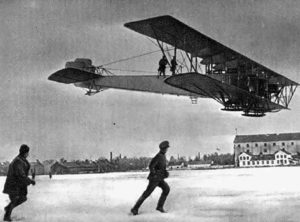At the time of the World War, there was only one black man who served in the Russian Imperial Air Force called Marcel Pliat.
Pliat was born in French Polynesia (now Tahiti) around 1890 to an African ancestry mother, who worked as a servant for a wealthy French man. The French man asked that Pliat’s mother follow him to Paris when he was leaving in 1907.
Somehow, Pliat and his mother ended up in Russia. Pliat grew up in St. Petersburg and graduated from a four-year factory school in Moscow trained as an auto mechanic. He fell in love with aviation during a visit to a show of airplane gymnasts.
He soon made Russia his true homeland. He learned the language, became a worker and even married a Russian woman with whom he had a child.
At the beginning of World War I in 1914, Pliat joined the Russian Army as a driver. He was later assigned to join the “Ilya Muromets“, a squadron of heavy bombers in Petrograd (formerly St. Petersburg) and the first of its kind in the world.
Pliat was trained and subsequently assigned to the 2nd Aviation Squad, where he worked as both a mechanic and machine gunner in the crew of bomber No. 10. Reportedly, his first combat flight took place on the night of February 24, 1915, when Russian bombers headed for the German town of Wallenberg now known as Velbark, Poland.

At a point, Pliat’s origin raised concerns among comrades, but he won their hearts with his dedication and professionalism.
According to Black Past, the plane was badly damaged by ground fire and the commander was wounded. Although Pliat nearly fell out of his firing point on the plane, his earlier initiative of tying himself with a rope to the plane before the flight saved him.
He was able to save a machine gun that flew out his plane during the engagement. Pliat was on the wing, supporting damaged engines for the rest of the flight.

“After the plane landed, one wing fell off and more than 70 holes were counted in the aircraft. The actions of Pliat and the rest of the crew ensured that the plane was not shot down or captured by the Germans,” according to reports.
On April 13, 1916, Pliat earned his first combat award during the bombing of the Daudzevas railway station near Riga, Latvia. Serving as a gunner on another Ilya Muromets bomber that knocked out two German fighters in November of 1916 earned him his second Cross of St. George.
After this flight, the designer of Muromets, Igor Sikorsky took Pliat’s suggestion on design adjustment recommendations for the aircraft and made the changes recommended by Pliat in the subsequent series of Muromets.
Pliat was a junior non-commissioned officer yet he received his 3rd-degree soldier’s Cross of St. George award – the highest soldier’s award in the Russian Army at that time. He was also promoted to senior unitary officer.










